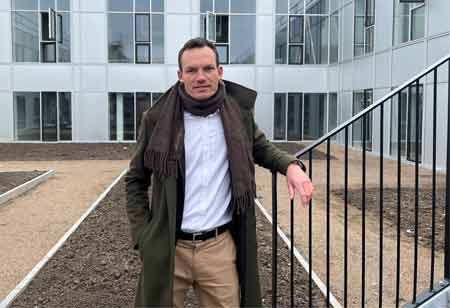Thank you for Subscribing to Construction Business Review Weekly Brief

DEAS Asset Management Sees Great Recycling Opportunities in Development Projects
A sentence that has been heard countless times in the iconic buildings situated in the suburb of Copenhagen, Søborg. It is not without reason that the area and the buildings are colloquially called "The TV City." For decades up until 2005 the buildings served as the headquarters and TV studios for the Danish state-owned media, ‘DR - Danmarks Radio’.
The Danish developer DEAS Asset Management, a part of DEAS Group, in collaboration with investors Fontaine A/S and Highbrook, has transformed and developed the area to now serve as state-of-the-art private residences with a great focus on responsible solutions. The project has been dubbed "Project Radio".
"This project shows how we in DEAS are working on optimizing sustainable solutions based on our investors' visions. With great respect for the history of the buildings, we have managed to rethink and create an area that combines multiple responsible solutions," says Milo Lillegaard Larsen, Senior Development Manager, Consulting and Space Planning at DEAS Asset Management.
Rebuilding rather than newbuilding
One thing is the history of the buildings, but where it really gets interesting is that the project in many ways reflects an important sustainability trend and important focus at DEAS Group: Rebuilding.
"For me, Project Radio is actually a textbook example of how and why any professional developer should aim to preserve as much as possible when developing an existing property," says Milo Lillegaard Larsen.
According to Hans Andersen, Senior Director of Sustainability at DEAS Group, there are significant savings in lifetime carbon emissions to be made by rebuilding rather than to build anew. This is evident from the experience gained in recent projects where there has been a focus on recycling in development projects.
"A large report in Denmark has concluded that there are massive CO2 savings when rebuilding. Having that report in our hands, we can see that the CO2 savings on Project Radio are approximately 50 percent when considering the lifecycle of the construction," says Hans Andersen.
The report that Hans Andersen is referring to is a report from the Danish construction industry collaboration "Renovation on the Agenda.” A study compared new construction with the renovation of an existing property. It shows that CO2 emissions are about 9 kg per square meter for new construction, but only 4 kg per square meter for rebuilding.
"What makes Project Radio so unique is the high degree of reuse. We have preserved the entire concrete structure from the 1960s, including the facades. This allowed us to reuse the embedded CO2. Yet, we today have a modern property that also meets the first environmental goal of EU taxonomy," says Hans Andersen.
A responsible solution
Project Radio is an A2020 construction, fully on par with a newly constructed property. The property is also updated for energy efficiency and built according to official energy standards.
Extensive insulation has been added, a new roof with solar panel systems, generating one-third of the building's shared installations, an indoor climate that meets all standards and a planned DGNB-in-use certification.
"It's been a highly complex project. When you rebuild, the building is static. Suddenly, you discover that a load-bearing concrete wall is in the way of a crucial ventilation system or is causing problems for solar panels. So, you have to consider the sustainability details within the existing structure. But it is possible as Project Radio proves," says Hans Andersen.
Moreover, there has been a strong focus on the social aspect. The apartments are of a smaller size, many of which are earmarked for young students.
"Here in Denmark, we know that it's challenging for young people to find housing, especially when they are students. Therefore, it was a condition for the investors that the property addresses this challenge.
Fortunately, we can see that the property is now buzzing with youthful life," says Milo Lillegaard Larsen.
Isn't it more sustainable to build something new and more efficient?
"The problem is that it's significantly more expensive. The next thing is that with rebuilding, we are able to reuse the embedded CO2 in the building structure. In other words, we extend the lifespan of the CO2 that has already been emitted," says Hans Andersen.
"What has been interesting about 'Project Radio' is that rebuilding has proven to be a solid business case. Reusing the embedded CO2 in the concrete structure is also economically sustainable. And most importantly the apartments were snapped up, and there has been almost no vacancy," says Milo Lillegaard Larsen.
The future is rebuilding!
The two experts from DEAS Group expect much more rebuilding in the future.
"We can see that there are fewer open fields for construction. Consequently, we are undoubtedly facing the need to focus more on existing buildings. Therefore, we have increased our focus on rebuilding moving forward. We are already in the process of assessing the rebuilding potential in the property portfolios we manage," says Milo Lillegaard Larsen.
The idea of recycling exists, but now it needs to become firmly established in the real estate industry, Hans Andersen adds.
"With rebuilding, I believe we are facing untapped potential in the market. What we are waiting for now is for the recycling market to gain more volume, allowing us to obtain large quantities of recycled materials needed for the larger property projects,” says Hans Andersen.








